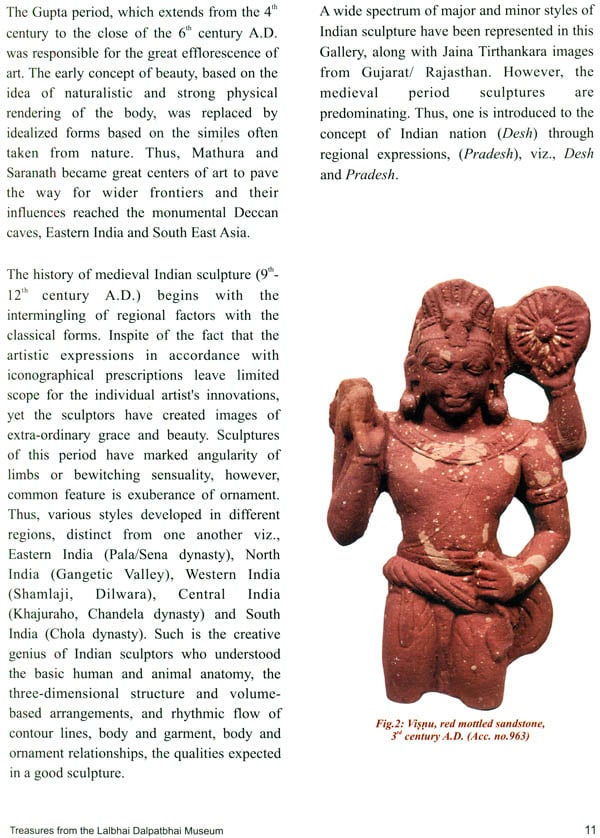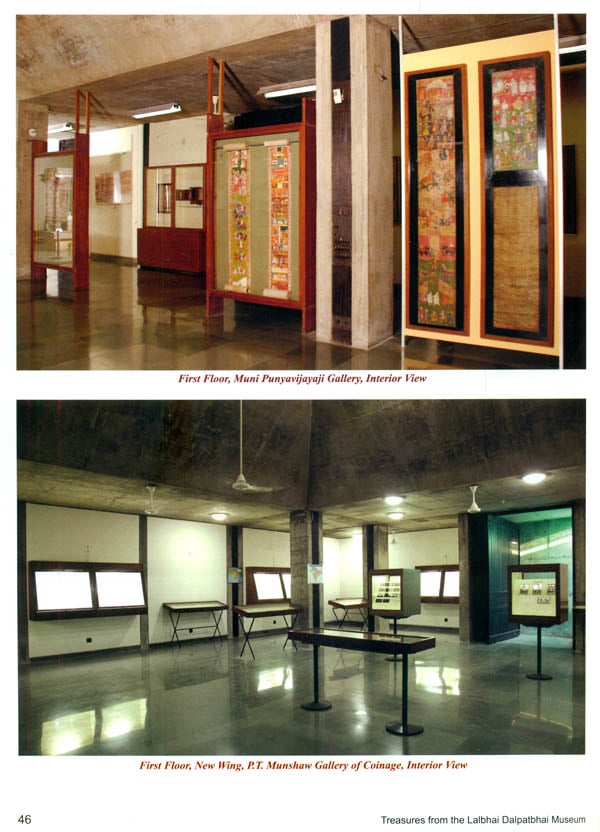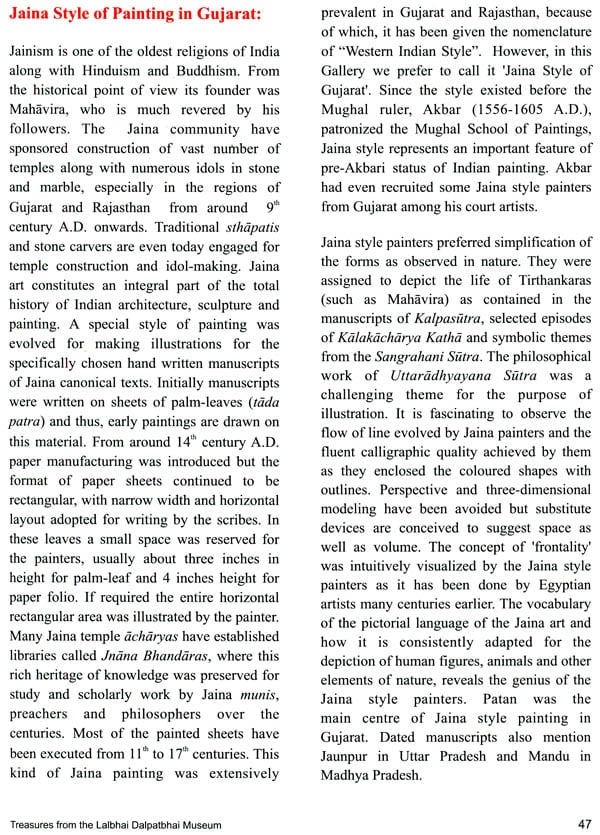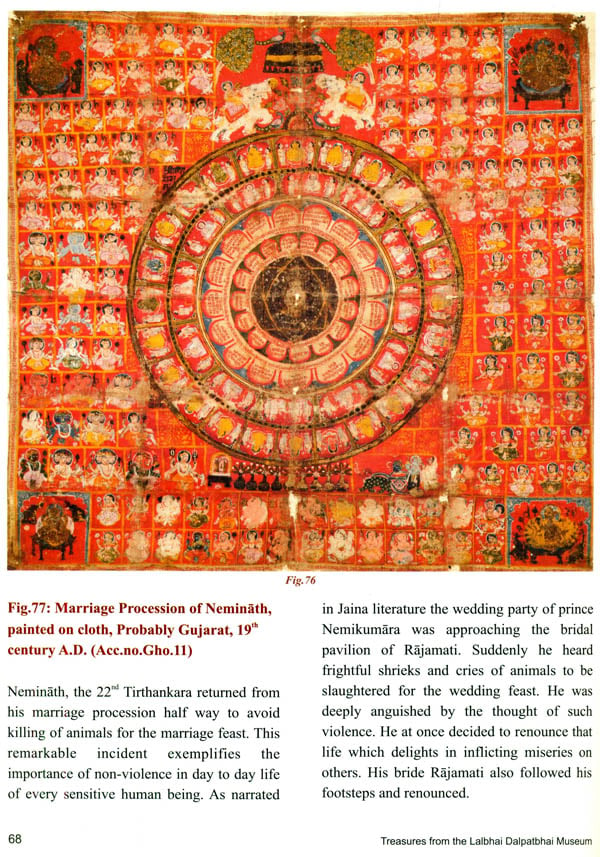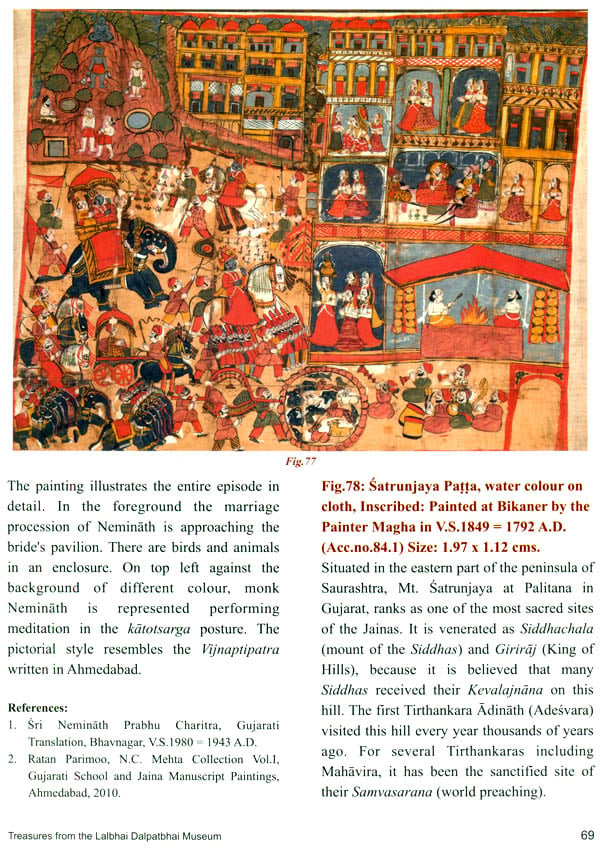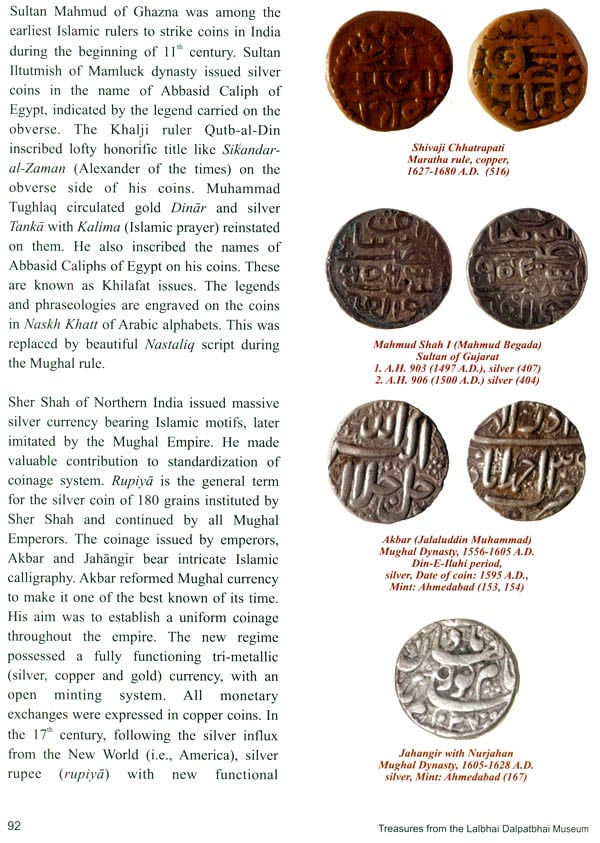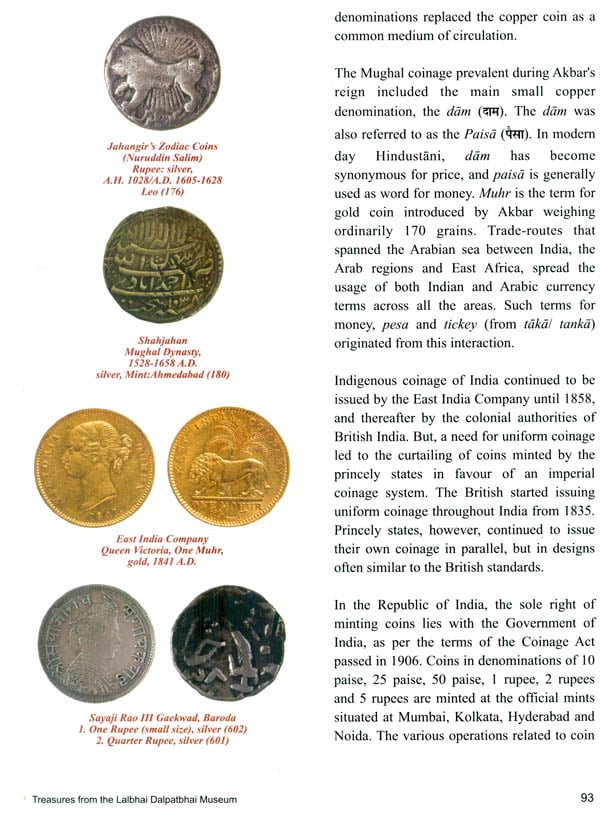
Treasures from the Lalbhai Dalpatbhai Museum
Book Specification
| Item Code: | NAN293 |
| Author: | Ratan Parimoo |
| Publisher: | Lalbhai Dalpatbhai Museum , Ahmedabad |
| Language: | English |
| Edition: | 2013 |
| ISBN: | 9788192848709 |
| Pages: | 104 (Throughout Color & B/W Illustrations) |
| Cover: | Hardcover |
| Other Details | 11.5 inch X 8.5 inch |
| Weight | 790 gm |
Book Description
The Vision: The Reorganization Plan from 2012 onwards
Lalbhai Dalpatbhai Museum during the last half a century has grown into one of the finest museums of Indian Art and Coinage in Gujarat as well as of the country. As the enclosed Time-Line shows, it is an achievement of art connoisseurship and munificence of a few Gujarati individuals, most of whom are related to one industrialist family and inspired by a Jaina Acharya. They were motivated by the urge to preserve the heritage and the desire to inculcate aesthetic sensibility and values among the people of the country in general and citizens of Ahmedabad in particular. Within the principal city of Gujarat, L.D. Museum is like a state museum next only to the very specialized Calico Museum of Textiles. Its foundation was laid with the setting up of Muni Punyavijayaji Collection of predominantly Jaina art (paintings and sculptures) in the new building of the L.D. Institute of Indology in 1963. With the donation of Smt. Madhuri Desai Collection of high quality sculptures ranging from different periods (from 2nd century onwards), the decision was taken by the eminent industrialist Shri Kasturbhai Lalbhai, to construct a new building. The internationally known Ahmedabad based architect, Shri Balkrishna Doshi designed the museum building, which was inaugurated in 1984 with two designated galleries, Smt. Madhuri Desai Gallery, ground floor and Muni Punyavijayaji Gallery, first floor. Initially the coins were displayed as a special temporary exhibition, but since 2004 it constitutes the third gallery. While the display of Kasturbhai Collection of Indian drawings is at the initial stages, the few important bronze pieces of Arvindbhai collection have been incorporated within the Smt. Madhuri Desai Collection of Indian Sculptures.
So far the focus of the Museum has remained on presenting the achievement of the hoary tradition of Indian sculptures and bronzes and also Indian paintings, particularly of Jaina subjects matter most of which are painted in Gujarat and Rajasthan. We are happy to announce that our Museum was selected in April 2012 for a substantial Financial Assistance programme by the Ministry of Culture, Government of India, New Delhi. With 50% of the Financial Assistance already received from the Ministry of Culture, the unfinished new first floor gallery has become operational and we are able to create a completely re-conceptualized and expanded Gallery of History of Coinage. The Gallery of Coinage enables to offer material evidences to support historical chronology of different ruling dynasties. It indirectly supplements the Gallery of Indian Sculptures. The display of the Gallery is conceptualized in such a manner that it aims at attracting the students of Commerce and Management. It covers varied specimens of "Currency from 5th century B.C. up to the 20th century". The gift of a set of beautiful bead work items from Saurashtra by Shri Mahesh Pandya, a citizen of Ahmedabad, will enable us to have a display of Gujarat Handicrafts.
Another popular section we expect to complete is the re-arranged display of Wood Carving panels and parts of domestic wooden architecture. Space is now available on the existing first floor to organize a representative display of about 50 selected high quality drawings of the Kasturbhi Lalbhai Collection. The beautiful gems of Indian miniature paintings in the N.C. Mehta collection are looked after by the L.D. Museum. The three collections combined together, viz., N.C. Mehta, Muni Punyavijayaji and Kasturbhai Lalbhai, make one of the most comprehensive collections of Indian-Paintings in the world in Ahmedabad. We are happy to inform that the Director General, Archaeological Survey of India, New Delhi, has conceded to our request and have recognized L.D. Museum, Ahmedabad, as the befitting museum to receive long term loan of sculptures, which are preserved in special storages near the important sites. Recently after negotiations with the officers of the Vadodara circle of ASI, we have been informed that the Director General has agreed in principle to give us selected sculptures from the historically famous Gujarat sites of Modhera, Patan and Kayavarohana (Karvana), as part of 150 years celebration of the AS!. These sculptures will be displayed in the space now available after renovation of the 1 SI floor hall of the new wing. We have also communicated with the Hon. Minister of Culture, Government of India, New Delhi. This new gallery of specific site sculptures from Gujarat will strengthen our over-all sculpture collection (along with existing sculpture collection on display, i.e., Smt. Madhuri Desai Gallery). We expect to have additional bronze objects also in this space.
After we are able to implement the above- mentioned re-organization of the galleries, we feel L.D. Museum together with N.C. Mehta Gallery should be given recognition of not only National level museum (Institution of National importance), but also status of Metro museum just as, are recognized the Indian Museum, Kolkata; Government Museum, Chennai and Chhatrapati Shivaji Maharaj Vastu Sangrahalaya (formerly known as Prince of Wales Museum), Mumbai.
I invite distinguished citizens and Art Lovers of Gujarat and Ahmedabad in particular, to join this venture by donating art objects in order to enrich the L.D. Museum Collections, so that it can claim to be the pride of Gujarat and achieve such a stature as Prince of Wales Museum is to Mumbai in Maharashtra.
The Lalbhai Dalpatbhai Bharatiya Vidya Mandir Trust would like to acknowledge their gratefulness to the Ministry of Culture for the sanction of a substantial grant of Financial Assistance since April 2012. The Director, L.D. Museum, would like to profusely thank the Trustees for their continued involvement, support and necessary approvals in the interest of the growth of the Museum. We also wish to record the assistance diligently rendered by Museum Keepers, Smt. Indubala Nahakpam (recently shifted to another post), Shri Vismay Raval and Ms. Bulbul Hinglajia. As in the past, Shri Anand Patel carried out the photography and Smt. Malti Gaekwad handled the design of the entire publication. We appreciate the collaboration of Shri Manoj Acharya and his very patient colleague Shri Ashwin Patel, who gave the final shape to the book on the computer designer's desk.
Preservation of Heritage has received great support from many individuals and activist groups in the recent decades. We want to draw attention that the museums, as in the past, are the eventual resting place of historical objects and artifacts and therefore dependable as far as Heritage Preservation is concerned. As in the Jaina tradition of Vijnaptipatra, we invite the citizens of Gujarat, India and the world to visit the museum. This book is both an invitation as well as it describes to the reader in the manner of a Vijnaptipatra (‘a amaru nagar chhe' - this is our town) 'this is what our museum has to offer'.
The Lalbhai Dalpatbhai Museum of the Lalbhai Dalpatbhai Bharatiya Sanskriti Vidya Mandir Trust, is a museum of Indian Sculptures, Bronzes, Manuscripts Paintings, Drawings, Miniature Paintings, ancient and contemporary Coins and Bead works, located in Ahmedabad. Ever since its inception in 1956, the L.D. Institute of Indology has been collecting and preserving rare manuscripts and artifacts of various kinds, some of which are handed over to the L.D. Museum. The Museum is the product of the vision and energy of two remarkable persons who were responsible for its establishment: Muni Shri Punyavijayaji, an erudite monk scholar and Sheth Kasturbhai Lalbhai, the well known industrialist of Ahmedabad. As the collection grew over the years the Board of Trustees of the Lalbhai Dalpatbhai Bharatiya Sanskriti Vidya Mandir Trust, felt strongly the need for a separate museum building to house the display of its collection. Consequently, a new museum building was built adjacent to the existing building of the Institute, which was also designed by the internationally acclaimed architect, Shri Balkrishna Doshi. The collection in the new museum building was opened to the public in 1984.
Location: The Lalbhai Dalpatbhai Museum is situated on a sprawling campus in the western part of the city in an area dotted with educational and research institutes, and in the vicinity of Gujarat University. It is about seven kilometres from the Railway Station and twelve kilometres from the airport, therefore, it is easily accessible from any part of the city.
Madhuri D. Desai Gallery: Smt. Madhuri D. Desai, an art connoisseur, collector and the daughter-in-law of the veteran freedom fighter and jurist, Shri Bhulabhai Desai, has been a major donor to the Sculpture Gallery named after her. The collection was donated in 1977/78. The Gallery is unique, since all the major regional styles of the sub-continent are represented here. The outstanding pieces include the largest head of Buddha (5th century) in stucco from Gandhara, the earliest cult image of Lord Rama (early 6th century) Gupta period from Deogarh (Madhya Pradesh), a rare figure of Matrika Indrani (6th century) from Shamlaji (Gujarat), the Adinath bronze image (7th-8th century) from Sirpur (near Nandurbar, Maharashtra), the splendid Jaina bronze images from Ghogha (Dist. Bhavnagar, Gujarat) and some of the finest examples of Buddha images from Mathura, Nalanda and Nepal/ Tibet. Besides, the Madhuri Desai Gallery includes some very superb Chola sculptures (lOth-12th century) from Tamil Nadu. A majestic group of four Tirthankaras from Ladol dating between n" and 13th centuries is displayed in Chaumukha arrangement. Recently has been added, a large new showcase displaying nine portrait statues of distinguished personages from Gujarat during the medieval period, which includes the Solanki King, Maharaja Jayasinha Deva (Siddharaj). The portraits are inscribed with the date of V.S.1285 = 1228 A.D. (that is, during the Vaghela period) and the find spot is Harij, near Patan.
Muni Punyavijayaji Gallery: The Museum has one of the finest collections of paintings in the Gujarati Jaina styles, some of which are painted before the Mughal period and are displayed in the Muni Punyavijayaji Gallery. The collection, which was assembled by the Muniji during 1940s, has some rare illustrated wooden book covers (patli) created for palm-leaf manuscripts. The Jaina pilgrimage paintings on cloth executed in 1433 A.D. at Champaner (Gujarat) is the earliest extant example of such a painting on cloth. Similarly, a Vijnaptipatra painted at Agra by the Mughal painter, Ustad Salivahana, in 1610 A.D., is the earliest painted document of its kind. It refers to the Mughal emperor Jahangir's farman prohibiting the killing of animals in his empire during the Jaina festival of Paryusana. Other outstanding examples on show include the earliest painted paper manuscript dated 1396 A.D., the illustrated manuscripts of the Kalakacharya Katha (c.1430) in Mandu style, the Matar Sangrahani Sutra (dated 1583 A.D.), painted by Chitara Govinda, the Sripaa Rasa (18th century), in the late Gujarat style; several rare cosmological diagrams called Adhidvipa (c.1440) and the Jaina Siddha-Chakra-Yantra. The Muni Punyavijayaji Gallery also has a section which highlights the age old tradition of wood carving in Gujarat.
Priyakant T. Munshaw Gallery of Coinage: This Gallery has on display a representative collection of historical phases of coinage of India, which was posthumously gifted by Smt. Nandiniben Munshaw in 2013 A.D. in memory of her husband. The collection includes the earliest punched-marked coins called bentbar (600 B.C.), Akbar's Din-i-Ilahi coin, Jahangir's Zodiac series in silver and Adil Shah's Larin (dated 1668 A.D.).
Shri Arvindbhai Collection: Among the objects gifted during 2007, on behalf of late Shri Arvindbhai, and on display are a flamboyant Chola style Nataraja (11th century), an exuberant Nepali/ Tibetan bronze Mandala (18th century), an elaborately decorated Chinese/Japanese style cupboard in wood. This gift has widened the scope of the various collections to grow into a Museum of Asian Art in the Gujarat region.
Shri Kasturbhai Lalbhai Collection: Acquired during 1940s, it comprises of a large collection of Indian drawings obtained from Abanindranath and Gaganendranath Tagore Family of Calcutta. It is represented by a display of more than a dozen exquisite drawings for Indian miniature paintings belonging to various regional schools, between 17th and 19th centuries. They are displayed for the first time with the objective of understanding the technical and the creative processes of traditional Indian miniature paintings.
CONTENTS
| 1 | Director's Preface | 1 |
| 2 | The Lalbhai Dalpatbhai Museum: Introduction | 3 |
| 3 | Timeline | 6 |
| Section I | ||
| 4 | Brief Summary of Indian Sculpture | 9 |
| 5 | Hindu Iconography | 12 |
| 6 | Buddhist Art | 14 |
| 7 | Art of Sculpture in Gujarat | 24 |
| 8 | Jaina Sculptures | 30 |
| 9 | Sculptures from Ladol | 31 |
| 10 | A Set of 9 Portrait Statues | 33 |
| 11 | Metal Sculptures | 36 |
| 12 | South India | 4 |
| 13 | Nepalese and Tibetan Buddhist Bronzes | 42 |
| 14 | Wood Carving | 44 |
| Section II | ||
| 15 | Jaina Style of Paintings in Gujarat | 47 |
| 16 | Other School of Indian Paintings | 56 |
| 17 | Sripala Rasa | 60 |
| 18 | Jaina Style of Paintings on Cloth | 64 |
| 19 | Ganjifa | 77 |
| 20 | Kavad | 79 |
| 21 | Kasturbhai Lalbhai Collection of Indian Drawings | 80 |
| 22 | Muni Punyavijayaji Memorabilia | 85 |
| Section III | ||
| 23 | Coinage of India | 90 |
| 24 | Bead- Work Collection | 94 |
| 25 | Short Biographies of the Donors | 96 |

